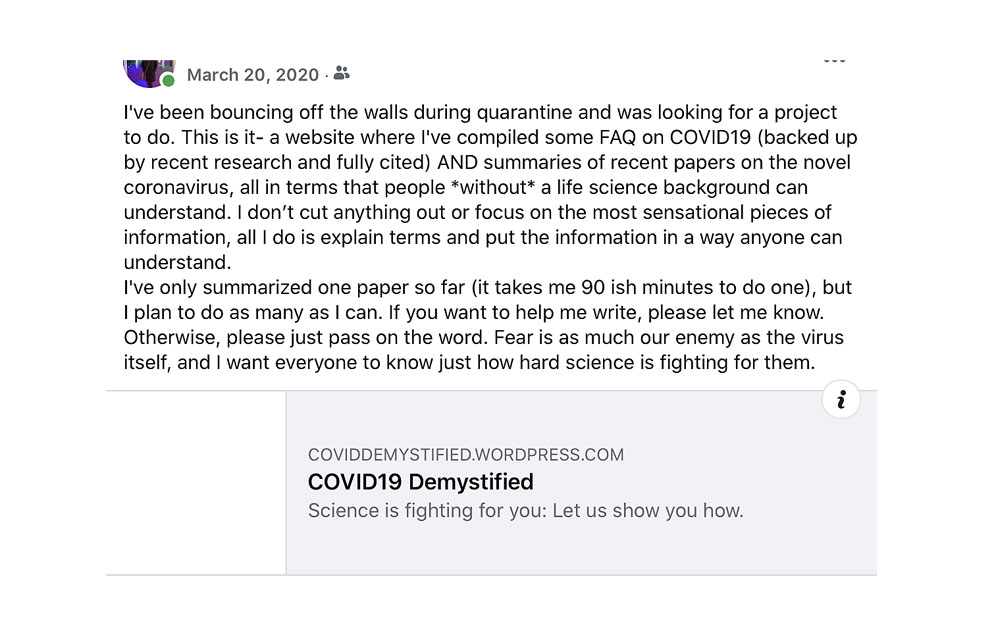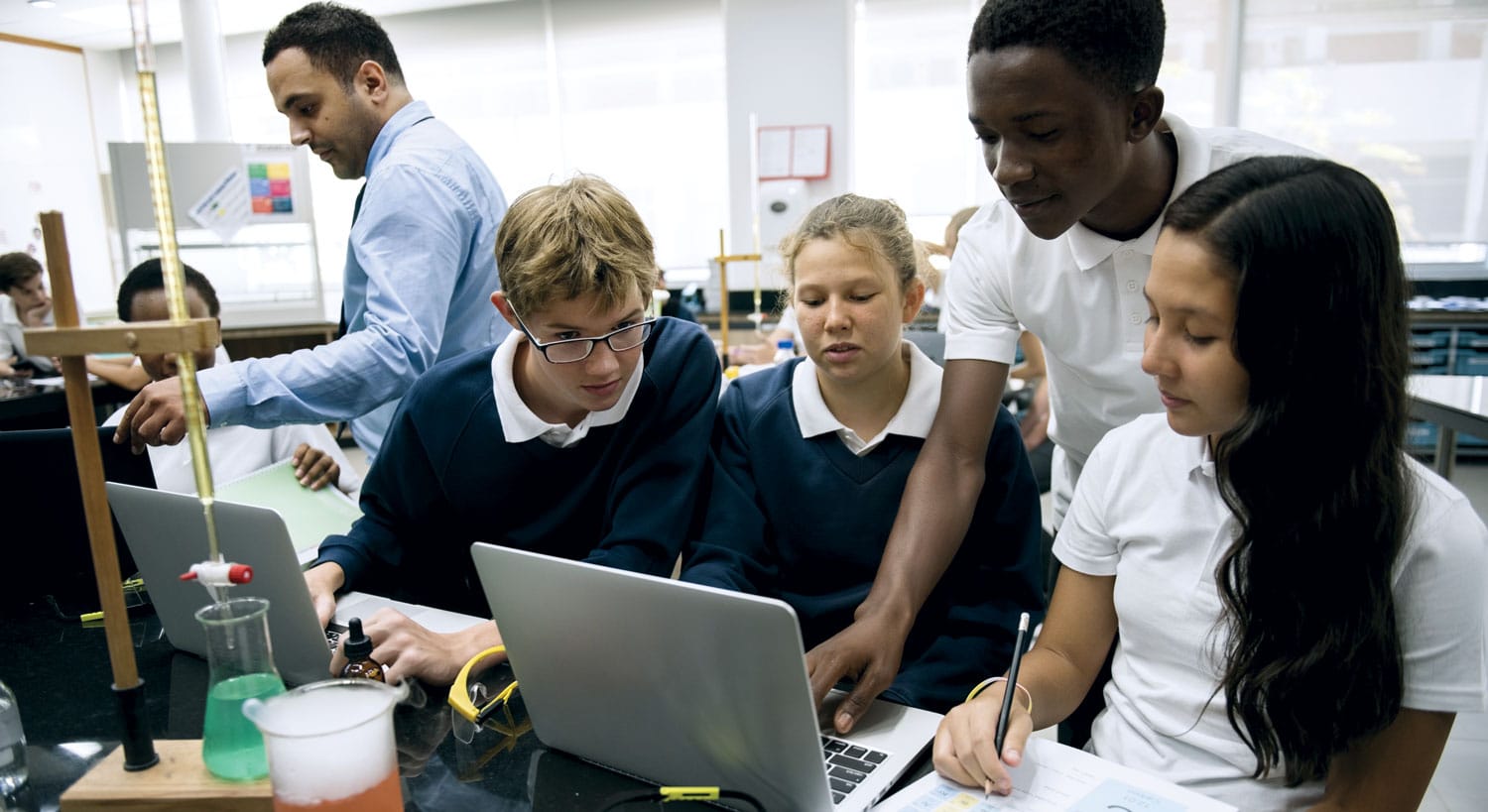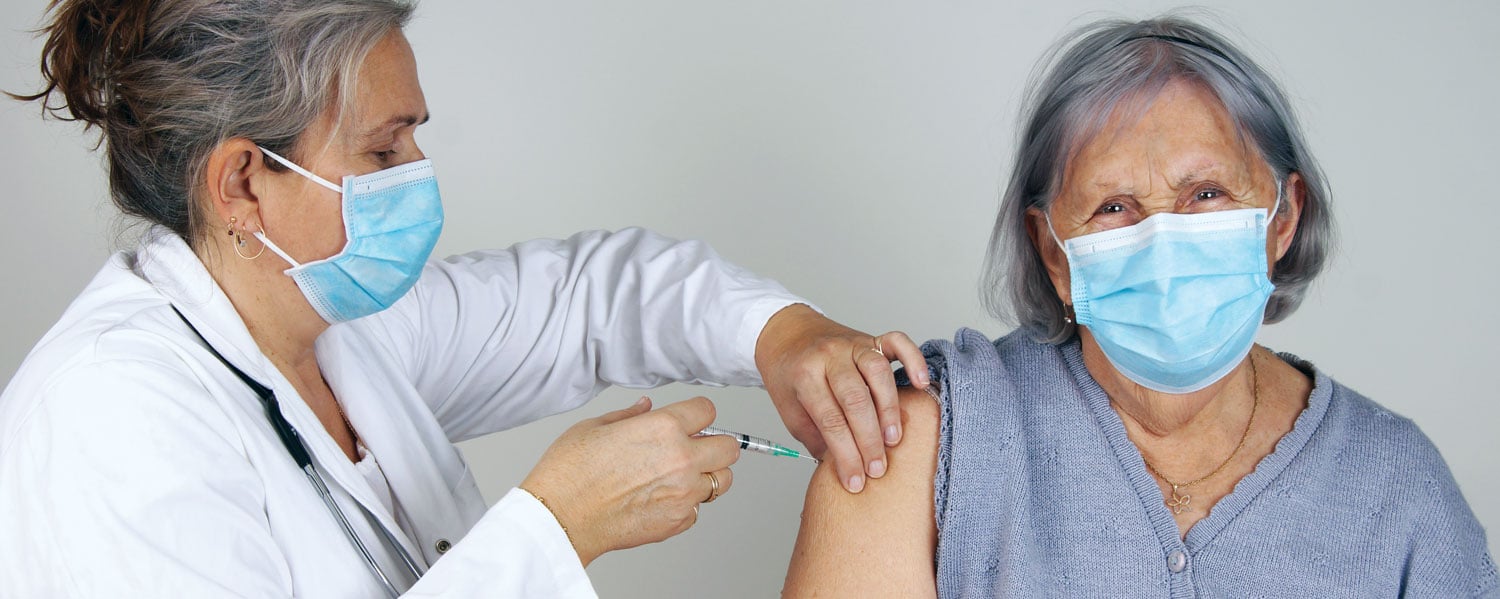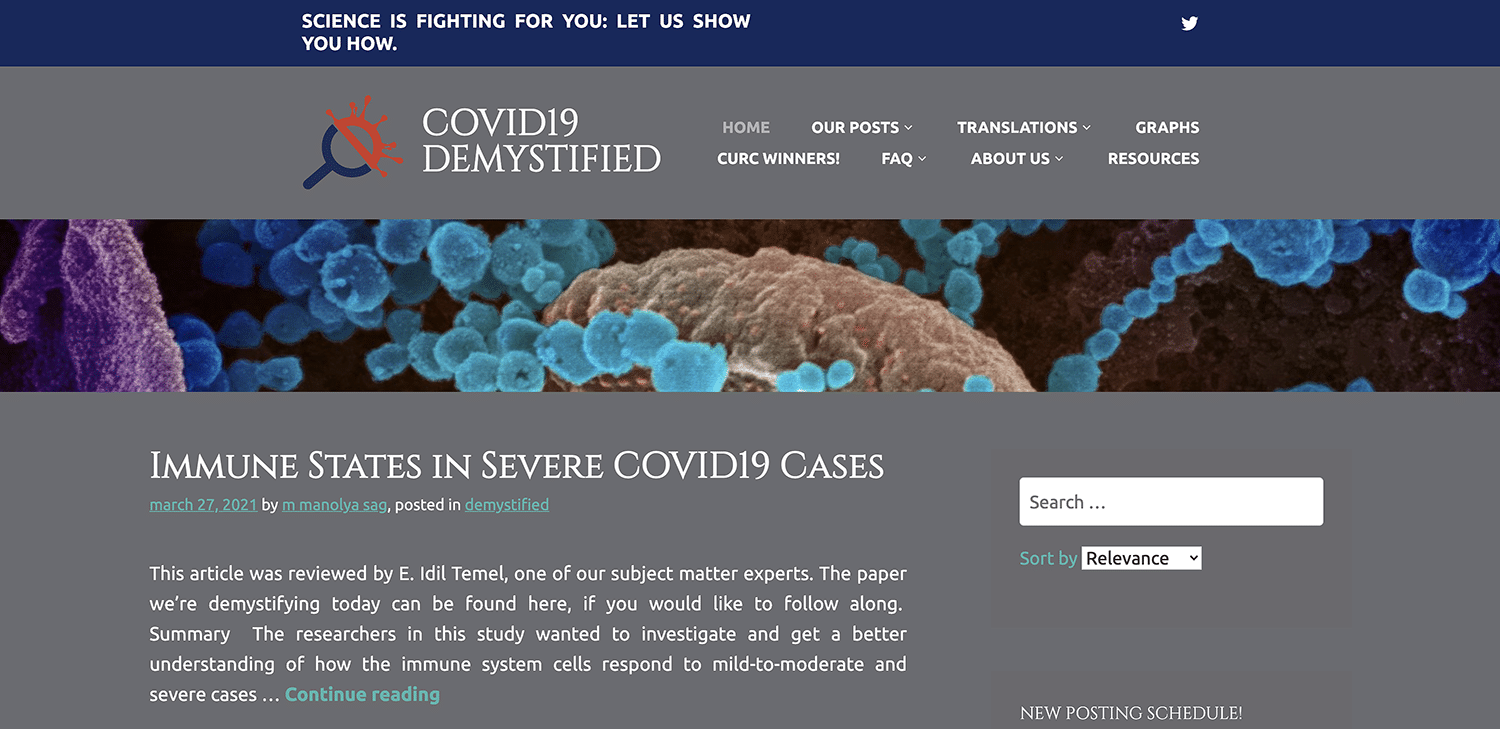
Some of the best things in life are born out of necessity and a demand for certainty.
It’s sometimes difficult to know what is or is not true these days and the fear and misunderstanding about COVID-19 is understandably prevalent.
There are still some questions and uncertainty surrounding COVID-19. But thanks to Lasya Vankayala, some of her classmates and a few subject matter experts, we now know more about SARS-CoV-2, the virus that causes the disease COVID-19, in terms the average person can understand.

Founder, Editor-in-Chief, Site Manager of COVID19 Demystified
On March 20, 2020, Lasya, a 4th-year Biochemistry Honours student at the University of British Columbia, was working in a lab on a co-op when it shut down due to COVID-19. She noticed that there was some misinformation in the media and that her friends and family were asking her a lot of questions about the virus.
The project started out as a google doc of information Lasya was collecting on SARS-CoV-2, which quickly turned into a basic website of FAQ’s. At the time, she had no idea that her simple website would quickly evolve into an important educational resource, accessed by thousands of visitors from 99 countries around the world.
We contacted Lasya and asked for an interview. She graciously took time out of her busy schedule to happily answer our questions about the project.
Teachers Life: Thank you so much for meeting with us Lasya. COVID19 Demystified has morphed into something so much bigger than a simple google doc. How did it grow so quickly in those first few months?
Lasya: It hit me pretty quickly that asking people to trust information on a public google doc probably wouldn’t go very far. I had some experience with running blogs so I decided to try and set up a website to host the FAQs. In the process I realized that there was some advantage in going directly to the published literature and walking others through how to interpret a paper.
Effectively, the idea was to teach others how to answer their own questions using scientific resources. Once I started writing, a lot of my classmates and friends heard about the project and asked about helping. I put a few posts on social media and soon enough we tripled our team. At one point our author team had over 15 students from across the country! It was really a project of the internet age and has been a joint effort by our entire team.

“Effectively, the idea was to teach others how to answer their own questions using scientific resources.”
TL: One of your first blog posts debunks the conspiracy theory that SARS-CoV-2 was created in a lab as a bioweapon. How did you find subject matter experts to review your break down of the research that is written in scientific language most people wouldn’t be able to make sense of?
L: Once I noticed the site getting some attention and traffic, I realized that we had a moral responsibility to ensure that everything we put out was as accurate as we could make it. I emailed some of my professors, including Dr. Scott Covey and Dr. Brett Finlay and asked them to review our articles.
After that, several of our authors brought their professors on. Our biggest influx of subject matter experts actually came from another call to action on social media. I explained what we were doing and what we needed and had a lot of scientists from all over the world reach out to me offering to review articles. Our very first blog post debunking the bioweapon theory was reviewed by Dr. Sebastian Lequime of the University of Groningen.
TL: That’s amazing. You had mentioned to me earlier that around this time you were posting 5-6 blogs per week. How were you managing all that work?
L: I had and continue to have lots of help from our authors and editors, so that definitely made it more doable. Still, at one point during the summer I was effectively working 12-13 hour days. My day to day was almost entirely reviewing posts, coordinating between our authors and editorial teams, sending drafts to reviewers, developing and improving the website, writing my own posts and coordinating with the various other initiatives we were partnered with. It was a full-time job!
TL: It almost sounds like two full-time jobs. One of your posts, A Crystal Clear View of the SARS-CoV-2 Protease, was cited in a Scientific Review. Can you tell us more about that?
L: I received an email from one of our expert reviewers earlier this year. I’d written a post summarizing work by his lab at Oak Ridge National Laboratories. He linked this Research Features article, where Dr. John Helliwell (one of the legends of the field) had mentioned my article as part of his personal thoughts on neutron crystallography. It was really amazing to see that such an esteemed researcher was reading our work.
TL: What an incredible validation and honour. Did that give you a little more energy to get through those long work days?
L: Knowing that our pieces were being read, and that they were drawing attention from scientists of that calibre was and is a big motivator.
TL: How are you able to keep the blog posts understandable and accessible to the average person? At what reading level would you say the posts are written?
L: We aim to write for a 9-10th grade reading level. There are websites out there that analyze pieces of writing and give you a predicted grade level, and we use those on most of our articles before posting.
There are some cases where the nature of the science may force us to write to a higher reading level (grade 11), but we try to avoid that. Our posts are generally written in an easy to access, narrative format and we really try to work through the science with our reader.
TL: The site seems like a great educational resource for high school science teachers. Have you had feedback from teachers who are using your information in their classrooms?
L: I’ve heard from our expert reviewers and from others who’ve visited our site that there are science teachers who are using our site to teach their students about COVID19! One of our reviewers told us about his friend, a teacher in Chicago, who has been using our site as a resource. Apparently it’s been pretty effective, which is amazing to hear.

TL: It is amazing and it’s something we would like to let Canadian teachers know about. What a valuable teaching resource. COVID19 Demystified seems to be a great model for other educational subjects. Have you thought about this regarding possible future projects?
L: Running this project has convinced me to add on ‘science communication’ to my future career path, so I’m definitely interested in applying this model to other subjects. For now, I’m focused on keeping COVID19 Demystified running for as long as it is needed.
TL: Speaking of science, I love how the blog reminds people to stick to the scientific method of getting facts vs. word of mouth or intuition. For example, in a beautifully written post by Jacob L. Fine, he ends by stating: “If we care at all for truth, facts, reason, logic, evidence, and reality then we must care for science. Only then can we cure the pandemic of misinformation.”
Do you think there is a greater mistrust of science now due to the massive amount of information thrown at us each day? Is the overwhelming task of curating all of that information to find the truth partly to blame?
L: I think there’s always a mistrust of anything we don’t understand; that’s not new. Science, especially biotechnology, has advanced very quickly in the last few years and the internet age has really made trying to keep up feel a bit like drinking from a firehose.
Curating all the information out there is definitely a challenge, which is why I think the real way to combat misinformation is to teach critical thinking and analysis. We can’t know every single new discovery that’s out there, but we can teach people to recognize misinformation or disinformation when they see it.
“…I think the real way to combat misinformation is to teach critical thinking and analysis.”
TL: The COVID19 Demystified site has some great educational resources like an interactive COVID-19 virus mutation tracker. When I hover over Canada, it shows that there are 9,772 unique variants. How do you calm fears about why there are so many mutations and reassure people that they’re not as scary as they sound? Also, The New and Emerging Respiratory Virus Threats Advisory Group (NERVTAG) has reported that the B.1.1.7 variant (U.K.) is associated with a 71% increase in transmissibility. Should we be worried about that?
L: The interactive virus mutation tracker is an amazing tool and our author Ryan did an amazing job highlighting it. Here’s how variants work: every time a virus copies itself, there is a chance for it to mutate. The vast majority of those mutations aren’t of concern. Some don’t actually do anything to the virus’ function and some are bad for the virus. The ‘variants of concern’ that we hear about are the small subset of mutations that change the virus in a particular clinical category.
For example, the variants may be better at infecting or transmitting from one person to another. There are a lot of mutations in SARS-CoV-2 because it’s transmitting a lot. We have scientific data showing that our vaccines are largely effective against the mutations out there. Many companies are working on boosters or updates to their vaccines to make them even more protective against the variants. That being said, there are versions of the virus that transmit more easily now so we need to stay vigilant. Wear your mask, keep your distance, and stay the course.
TL: How do you feel about Canada’s vaccination plan? What would you have done differently?
L: I’m not a public health expert so I’m not sure if I know what would be the best vaccination plan. I do wish that Canada had more in-country vaccine research and hope that we can rebuild our vaccine infrastructure in the future.
TL: Which of the current vaccines that have been released do you feel is the best and why?
L: All the vaccines currently released have been tested and are protective against death and severe disease. Any amount of protection is better than 0% protection, and by that logic the vaccine you can get is the best vaccine.

TL: Recent news in Ontario has come out stating that only 71% of our oldest residents have been vaccinated for COVID19. Are you seeing the same type of numbers in B.C? And if so, is this concerning?
L: I’m not sure of the exact percentage of seniors in BC who have received the vaccine, but I know we are currently vaccinating those aged 73+. I hope targeted vaccine education programs and conversations about the importance of vaccines can help us increase how many members of our population are vaccinated.
TL: Tell us about your partnership with the Canadian Undergraduate Research Competition.
L: The Canadian Undergraduate Research Competition is a great initiative that encourages talented undergraduate students to write their own research-style articles on COVID19. We were contacted by some of the organizers and asked whether we could feature some of the winning submissions on the website. It’s always awesome to see work by the scientists of the future!
TL: I see that your posts are being translated into multiple languages. How did that start?
L: It started mid-summer 2020 when one of our authors (William Ding) asked whether we’d considered translating our articles into Simplified Chinese. He wanted to share our articles to combat some of the misinformation circulating on platforms such as WeChat and Whatsapp, so he jumped on as one of our first translators. Since then, a lot of our multilingual authors have been picking up our already published articles and translating them into other languages.
TL: How do you think “pandemic fatigue” and going into warm weather could affect what happens over the next couple of months with infection rates?
L: I know everyone’s probably pretty tired of pandemic life, I know I am! I think we’re really in a ‘make or break’ stage for this pandemic. We have vaccines and have started vaccinating our population but if people break public health orders or rush the return to normal we risk setting off a massive wave of infections before we have enough people vaccinated. This then opens up the risk of more variants or of infecting vulnerable people who haven’t been vaccinated yet. We need to stay the course and keep everyone else in mind.
I want to say to my fellow 20-somethings:
I know the last year has been difficult. We’ve missed out on seeing friends, attending classes, and having our graduation ceremonies. I know a lot of you are working front-line jobs and putting yourselves at risk to keep things running. Pandemic fatigue is setting in hard now, but we need to stay the course. Young people can catch the virus and spread it to many others, including seniors. We need to keep being responsible: stay home when we can, wear a mask when we can’t, and keep everyone around us safe.
“Pandemic fatigue is setting in hard now, but we need to stay the course.”
TL: Thank you Lasya for Demystifying Covid19 for us and for creating such a great educational resource for teachers and anyone else who wants to learn more about Covid19 and science.
L: Thank you so much Lia and Teachers Life for taking the time to highlight our site! This initiative wouldn’t have been possible without our amazing authors, editors and reviewers and a lot of the credit belongs to them. I know I speak for the entire COVID19 Demystified team when I say it’s been a pleasure to share the science with our readers.
We’re going to keep writing and demystifying the research for as long we can. If you’re interested in helping: as an author, editor or expert reviewer, send me an email at lasya@coviddemystified.com. Also, please check out the website and share it with your friends. Science is fighting hard for us, and we at COVID19 Demystified want to highlight every victory.
Learn more at: www.coviddemystified.com
All articles and other information posted on http://teacherslife.com are intended to be informational only and not for the purpose of providing any health, medical, financial, insurance, legal, accounting, tax or other advice. Teachers Life does not guarantee or represent that any information in these articles or elsewhere on this website is accurate, complete, current or suitable for any particular purpose. You use or rely on such information solely at your own risk. All articles and website content are the property of Teachers Life and all rights are reserved. IN NO EVENT WILL TEACHERS LIFE BE LIABLE FOR ANY LOSS OR DAMAGE YOU INCUR RELATED TO YOUR USE OR RELIANCE OF THE INFORMATION IN THESE ARTICLES OR ELSEWHERE ON THE WEBSITE. See the Terms of Use for more information.

